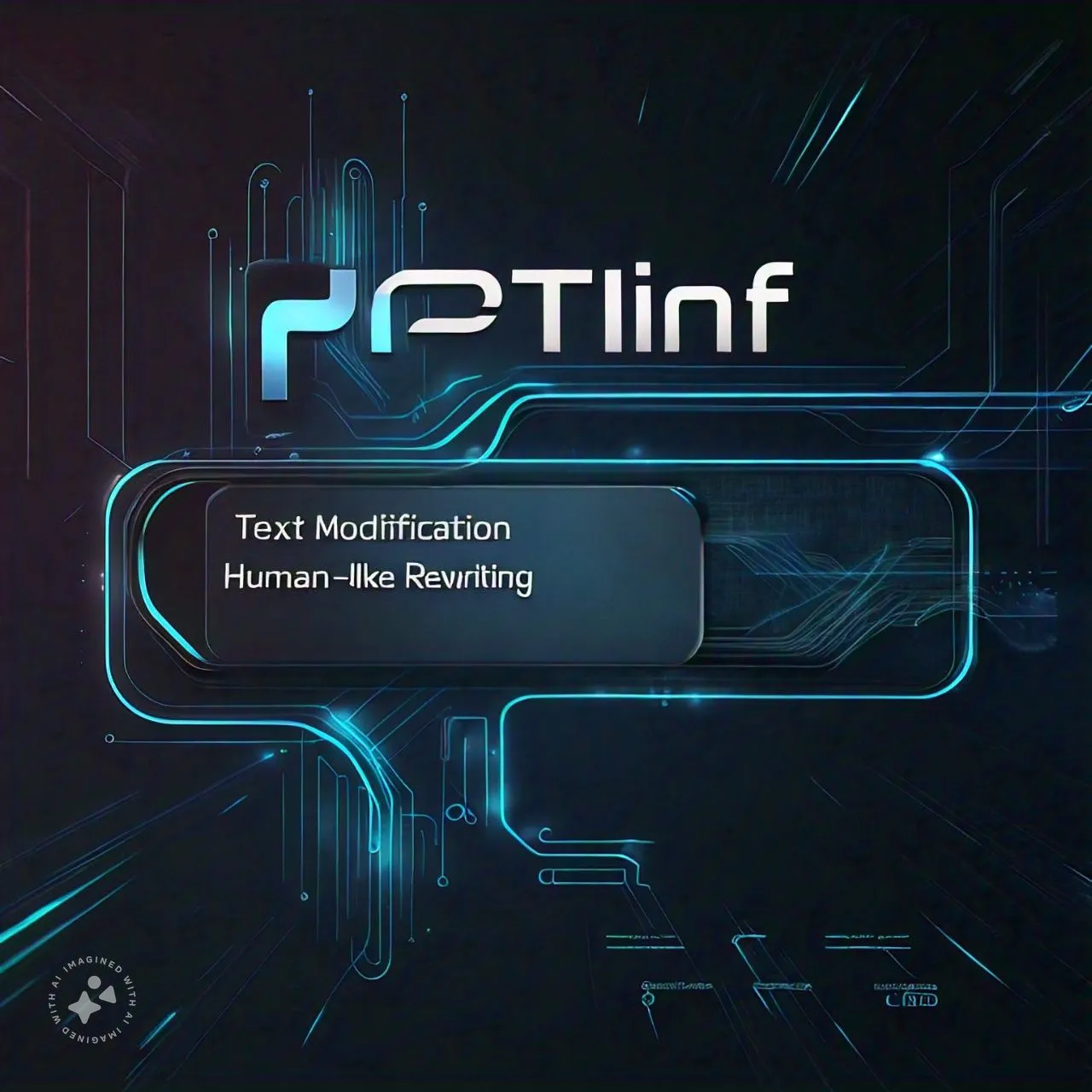What is GPTInf?
GPTInf is a tool that claims to modify AI-generated content. It aims to make AI text appear more human-like, bypassing various AI detection methods. The goal is to help content bypass AI detection tools using AI text humanization techniques.
How GPTInf Works

GPTInf takes AI-written text as input. It then rephrases the content to ensure it can pass AI detection software. The tool uses several methods:
- Introducing more diverse vocabulary
- Varying grammar structures
- Changing sentence patterns
These changes are meant to remove typical AI writing patterns. This makes the text harder for AI detectors to spot.
Key Features of GPTInf
Freeze-List Function
GPTInf has a “freeze-list” feature in beta. This lets users keep certain words or phrases unchanged, bypassing AI content detectors such as GPTZero. It helps preserve key content during rewrites while ensuring it can pass AI detection.
Claims to Bypass Top Detectors
The tool says it can fool advanced AI detectors. These include Originality.ai, one of the popular AI detectors. and Winston AI.
Simple Interface
GPTInf has a minimalist design. It avoids complex options. This makes it easy to use.
Flexible Pricing
GPTInf offers different pricing plans. Users can choose monthly or yearly billing. Plans start at:
- $12 per month for popular AI tools.
- $8 per month (billed yearly)
This covers 10,000 words, making it efficient for AI enthusiasts who create large volumes of content. Users can increase word counts as needed. Plans go up to 500,000 words per month.
Why People Are Interested in GPTInf
Many website owners want to create content faster. AI writing tools help with this. But Google may penalize AI-detected content. Tools like GPTInf claim to solve this problem. They promise to make AI text seem human-written.
Testing GPTInf: Does It Really Work?

To check GPTInf’s claims, we ran some tests. Here’s what we did:
- Generated an AI-written article using ChatGPT
- Ran the original text through top AI detectors
- Processed the text with GPTInf
- Tested the GPTInf output with the same detectors
We used these AI detection tools: GPTInf and other popular AI content detectors.
- Originality.ai
- Writer AI
- GPTZero
- Content at Scale
- ZeroGPT
Test Results
Originality.ai Results
- Original ChatGPT text: 100% AI, 0% Human
- GPTInf version: 100% AI, 0% Human, easily detected by AI content detectors.
GPTZero Results
- Original ChatGPT text: 100% AI, 0% Human
- GPTInf version: 100% AI, 0% Human
Writer AI Results
- Original ChatGPT text: 18% AI, 82% Human
- GPTInf version: 19% AI, 81% Human
Content at Scale Results
The GPTInf output was mostly marked as AI-generated. It “reads like AI” according to this tool.
ZeroGPT Results
ZeroGPT gave a 90.04% chance of AI generation for the GPTInf text.
Analysis of Test Results
The results show that GPTInf didn’t significantly change AI detection outcomes. Most tools still flagged the content as AI-written. Only Writer AI thought both versions were mostly human-written. But Writer AI seems less accurate overall compared to other writer AI detection platforms.
Comparing GPTInf to Other Tools
AIHumanizer: An Alternative Option
AIHumanizer is another tool for making AI text seem more human through advanced AI text humanization techniques. It claims to offer:
- More features than GPTInf
- Better content quality can be attained using best AI tools, including popular AI detectors.
- Consistent performance can be achieved with undetectable AI tools to pass AI detection.
- Affordable pricing
- User-friendly design
AIHumanizer says it can bypass detectors like:
- GPTZero
- Writer.com
- Turnitin
- Scribbr
- Originality.ai
It also aims to keep the original meaning intact, while ensuring it’s undetectable by AI content detectors.
Testing AIHumanizer
We ran similar tests on AIHumanizer. Here are the results:
Content at Scale
AIHumanizer’s output passed as human-written.
GPTZero
GPTZero thought the AIHumanizer text was likely human-written. Only a small part seemed AI-generated.
Originality.ai
Originality.ai was 89% confident the AIHumanizer text was human-written, proving the effectiveness of modern AI algorithms. Some parts still seemed AI-generated, but it largely passed.
Writer
AIHumanizer’s content passed Writer’s AI detection easily.
ZeroGPT
ZeroGPT gave AIHumanizer’s text a “human written” rating. It found only a 20.2% chance of AI generation, highlighting the effectiveness of AI content detectors like originality.ai.
Pros and Cons of Using AI Bypass Tools
Potential Benefits
- Faster content creation
- Avoiding AI detection penalties
- Using AI as a writing aid without fear of being flagged by AI detection software.
Possible Drawbacks
- Ethical concerns about disguising AI text arise with the use of AI bypass platforms.
- Risk of detection if tools aren’t perfect, even with advanced AI algorithms.
- Potential loss of original meaning or quality
- Dependence on third-party tools
Ethical Considerations
Using AI writing tools raises some ethical questions. Is it okay to present AI-written text as human-written? There are differing views on this. Some see it as a helpful tool. Others worry about honesty and transparency.
Best Practices for Using AI in Content Creation
If you choose to use AI writing tools, consider these tips to create undetectable AI content:
- Use AI as a starting point, not the final product
- Add your own insights and experiences to make the content undetectable by AI content detectors such as GPTZero.
- Fact-check all AI-generated information
- Disclose AI use when appropriate
- Focus on providing value to readers and bypass AI content detectors.
- Don’t rely solely on AI bypass tools
The Future of AI Writing and Detection
The battle between AI writers and detectors will likely continue. As bypass tools improve, so will detection methods from various AI detection software. This could lead to:
- More sophisticated AI writing models
- Advanced linguistic analysis in detectors like originality.ai can enhance detection accuracy.
- Potential regulations on AI-generated content
- New ways to blend human and AI writing
Alternatives to AI Bypass Tools
Instead of trying to fool AI detectors, consider these options:
- Use AI for research and outlining only, ensuring the final text remains undetectable by AI content detection.
- Blend AI suggestions with your own writing to pass AI detection software.
- Employ human editors to refine AI drafts
- Develop your own unique writing voice
- Focus on original research and insights to make your work undetectable by AI content detection.
Conclusion: Is GPTInf Worth It?
Based on our tests, GPTInf didn’t consistently bypass AI detection tools, so consider GPTInf alternatives. While it offers some useful features, its effectiveness seems limited. AIHumanizer showed better results in evading detection.
However, focusing solely on bypassing AI detectors may not be the best approach. Instead, consider using AI tools responsibly as part of a broader content strategy, and ensure results are undetectable by AI content detectors. Prioritize creating valuable, original content that serves your audience, making it undetectable by AI content detectors.
Remember, the landscape of AI writing and detection is rapidly evolving. What works today might not work tomorrow. The best long-term strategy is to develop your own authentic voice and provide genuine value to your readers.
FAQs About GPTInf and AI Writing
Is GPTInf free?
No, GPTInf offers a free trial but requires a paid subscription after that. It could be an alternative to GPTInf against GPTZero.
How accurate are AI detection tools?
Accuracy varies between tools. Some are more reliable than others. No tool is 100% accurate.
Can Google detect AI-written content?
Google doesn’t publicly confirm specific AI detection methods. But it aims to reward high-quality, helpful content regardless of how it’s created, ensuring it’s undetectable by AI content detectors.
Are AI writing tools ethical to use?
Opinions differ on the best AI tools for creating undetectable content. It depends on how they’re used and whether their use is disclosed.
How can I make my AI-generated content less detectable?
Add personal insights, vary sentence structures, and thoroughly edit the content to bypass AI content detectors. Don’t rely solely on automated tools.


